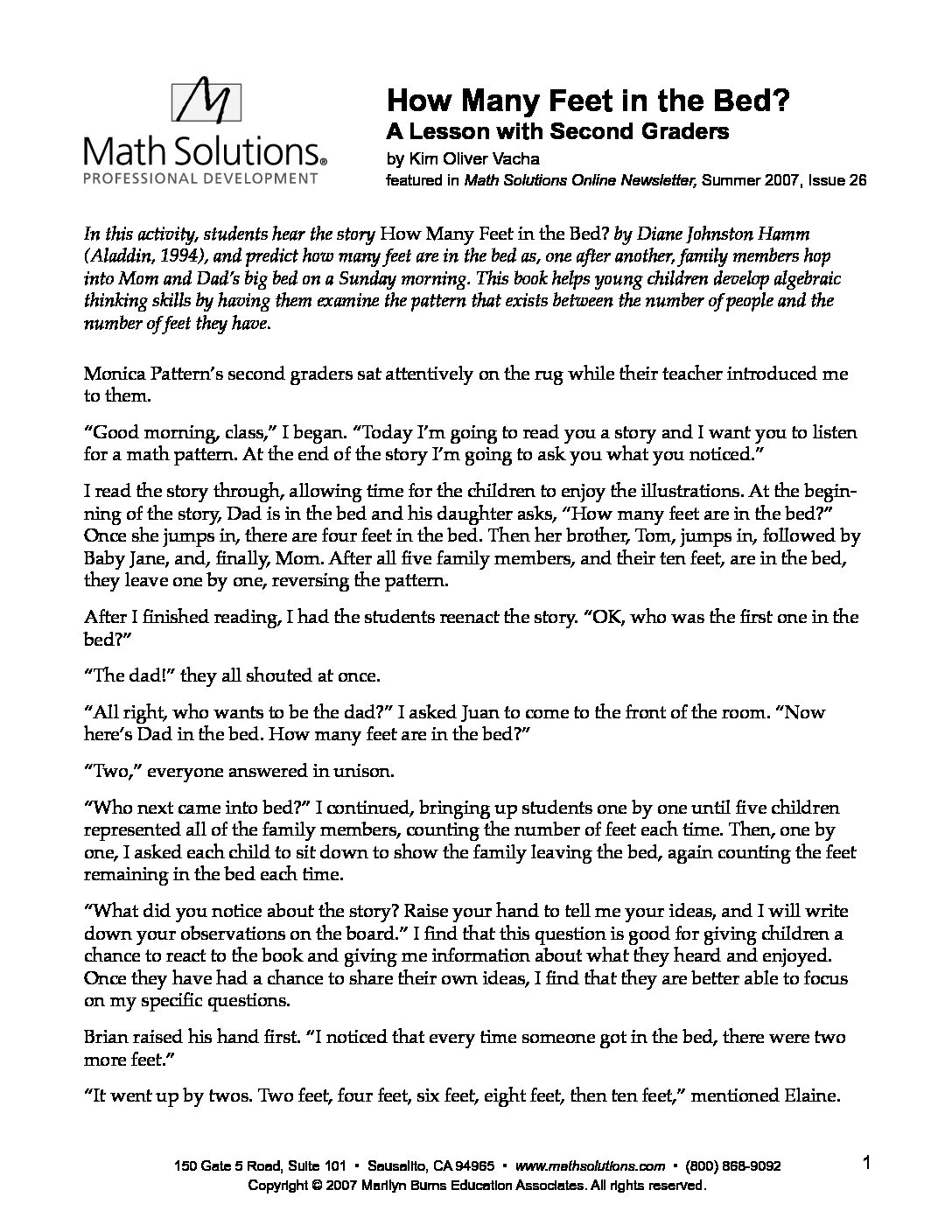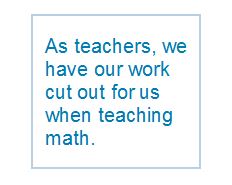New content here
Bolded!
blockquote stuff here

the caption goes here.
I’ve had similar experiences myself. When shopping in Macy’s during a “25 percent discount taken at register” sale, a woman with a $24.95 sweatshirt in hand asked me if I knew how much the discounted price would be. I almost slipped into teacher mode, thinking about questions to ask her to help her figure it out for herself. But I caught myself. She didn’t want a math lesson— she just wanted the information. So, in my head, I figured that a fourth of $24 is $6, so she’d save a little more than $6. I subtracted $6 from $25, and said to her, “It will be just under $19.”
I’ve had similar experiences myself. When shopping in Macy’s during a “25 percent discount taken at register” sale, a woman with a $24.95 sweatshirt in hand asked me if I knew how much the discounted price would be. I almost slipped into teacher mode, thinking about questions to ask her to help her figure it out for herself. But I caught myself. She didn’t want a math lesson— she just wanted the information. So, in my head, I figured that a fourth of $24 is $6, so she’d save a little more than $6. I subtracted $6 from $25, and said to her, “It will be just under $19.”
I almost slipped into teacher mode, thinking about questions to ask her to help her figure it out for herself. But I caught myself. She didn’t want a math lesson— she just wanted the information. So, in my head, I figured that a fourth of $24 is $6, so she’d save a little more than $6.
I almost slipped into teacher mode, thinking about questions to ask her to help her figure it out for herself. But I caught myself. She didn’t want a math lesson— she just wanted the information. So, in my head, I figured that a fourth of $24 is $6, so she’d save a little more than $6.
I almost slipped into teacher mode, thinking about questions to ask her to help her figure it out for herself. But I caught myself. She didn’t want a math lesson— she just wanted the information. So, in my head, I figured that a fourth of $24 is $6, so she’d save a little more than $6.
In an email to me after her trip to the supermarket, my friend Ann wrote:
I asked for one-fourth of a pound of the already sliced turkey. The deli person pulled out a huge hunk of turkey and I saw .40 on the scale. As the deli person was about to wrap the hunk, I said, “That’s too much; I can’t use that much fast enough.”
She looked surprised and removed one slice.
“It’s still too much—point forty is nearly half a pound,” I said and added, “One-fourth is really point twenty-five, but point thirty would be OK.”
“No,” the deli person insisted, “one-quarter is point twenty-five, but one-fourth is point forty.”
I couldn’t stop myself and said, with as much authority as I could, “A quarter of a pound and a fourth of a pound are the same thing.” She looked amazed . . . and skeptical.
Marilyn, you have your work cut out for you.
Ann’s message is a reminder that all of us as teachers have our work cut out for us.
I’ve had similar experiences myself. When shopping in Macy’s during a “25 percent discount taken at register” sale, a woman with a $24.95 sweatshirt in hand asked me if I knew how much the discounted price would be. I almost slipped into teacher mode, thinking about questions to ask her to help her figure it out for herself. But I caught myself. She didn’t want a math lesson— she just wanted the information. So, in my head, I figured that a fourth of $24 is $6, so she’d save a little more than $6. I subtracted $6 from $25, and said to her, “It will be just under $19.”
And one more. I treated myself to a pedicure a few days ago, a welcome break from my computer. I overheard the woman in the chair next to me ask, “Do you do head and neck massages?” The woman doing her nails answered, “Yes, it’s $15 for ten minutes.” The woman in the chair then asked, “How much would it cost for fifteen minutes?” There was a long silence. A really long silence. The woman doing her nails had stopped working and both of their foreheads were scrunched with that look I see on students who are thinking hard. My friend Ann was right—we do have our work cut out for ourselves.
I’ve thought about the deli person’s confusion, the reason why the woman in Macy’s didn’t feel she could figure out the sale price, my experience at the nail salon, and situations like these that come up with students. When teaching in the classroom, it’s important that we probe to understand how students think and reason, and that  we encourage them to persevere to find solutions for themselves. To that end, we need to know what students know, what they haven’t learned yet, and what misconceptions they have. In the classroom, this calls for having students explain their reasoning for answers they give, whether those answers are right or wrong. When teaching, I’m diligent about asking students, “How did you figure that out?” And I’ve found that after a while, students automatically explain their reasoning as part of their answers, without being prompted. Then my task shifts to listening carefully to what the students are saying and asking questions if I need to in order to understand their thinking. This helps me know whether my students are prepared to handle the everyday math problems they’ll encounter in real life with confidence or, if not, what I need to do to get them there.
we encourage them to persevere to find solutions for themselves. To that end, we need to know what students know, what they haven’t learned yet, and what misconceptions they have. In the classroom, this calls for having students explain their reasoning for answers they give, whether those answers are right or wrong. When teaching, I’m diligent about asking students, “How did you figure that out?” And I’ve found that after a while, students automatically explain their reasoning as part of their answers, without being prompted. Then my task shifts to listening carefully to what the students are saying and asking questions if I need to in order to understand their thinking. This helps me know whether my students are prepared to handle the everyday math problems they’ll encounter in real life with confidence or, if not, what I need to do to get them there.
Classroom Suggestions
Below are two ideas for students who have studied about fractions and percents, and a third suggestion about how to adapt my Macy’s experience for younger students.
- If your students have experience with fractions and percents, read Ann’s email to them. Ask them how they might respond to the woman at the deli counter. Have them share their ideas with their partners. And then lead a class discussion for them to report their ideas. (This think-pair-share instructional strategy is a staple in my teaching.) I like ending lessons with writing assignments. Here, give a sentence frame for students to complete: To help the deli worker understand, I would . . .
- A problem like the one I faced at Macy’s presents an opportunity for students to engage with mental math, which is important for helping them develop and hone their numerical reasoning skills. If your students have studied about percents, give them the Macy’s discount problem and ask them to figure out mentally about how much the discounted price would be. Then talk about their different strategies. Again, have them think alone first, then talk with their partners, and then report to the class.
- Simpler versions of the Macy’s problem can work for younger students, using a dollar amount for the discount instead of a percent. For example: If a sweatshirt costs $25 and is on sale for $19, how much would you save? Choose numbers that students can deal with in their heads. I’ve found it helpful to set up the word problem by writing on the board:
A sweatshirt costs $_____.
The sale price is $_____.
You save $____.
Then I can fill in numbers that are appropriate and also leave different amounts blank to vary where the unknown is. Following are three versions of the sweatshirt problem using different numbers, with the unknown in a different position in each:
A sweatshirt costs $25.
The sale price is $19.
You save $____.
A sweatshirt costs $30.
The sale price is $____.
You save $7.
A sweatshirt costs $____.
The sale price is $15.
You save $4.
Finally, for an individual assignment, ask students to copy the problem with three blanks, decide on numbers to use for two of the blanks, and solve the problem mentally. Ask them to write an explanation of how they reasoned. Then have students share their thinking.


I was extremely happy to find your blog. So much of what I’ve learned about teaching math has come from you! These suggestions are great. Thank you.
Jan
Laughter and Consistency
Marilyn,
Thank you for starting this blog. I have 2 comments:
Years ago, a colleague of mine in the Math department, had a special schedule where she only worked a portion of the school day and was deemed a 2/3 employee. She noticed something amiss after checking several of her paychecks. The business office used a decimal approximation of 2/3 when calculating my friend’s salary instead of the exact value of 2/3. When this was brought up the the office employee, she apologized for the error and stated she would use .666 instead of .66 to which my friend gently protested. She finally was able to convince the office worker to use 2/3 instead of a decimal. If my friend had not checked her pay stubs or was not paying attention to the “math”, she would have been shorted hundreds (maybe thousands) of dollars depending on how long this arrangement lasted!
2nd Comment: When my middle daughter was young, she liked to figure out the tip and give it to the server. Sometimes, my husband would forget to let my daughter figure out the tip on her own and would just hand it to her. When that happened, I would ask my daughter to figure out the cost of the bill based on what her Daddy had given her knowing we give a 20% tip.
Thanks again. I look forward to reading your future posts!
I had a similar experience at a local pizza parlor. My husband and I ordered a take-out pizza, paid with our credit card, and sat down to wait. We changed our minds and decided to eat in, so I went back up to the register and asked for 2 medium sodas. The total was $3.49. I handed the teenager a $5 bill. She just looked at me. I could tell she was struggling to give me change. She offered an explanation: her cash register was not working properly that day. As I tried to tell her how much change she owed me, she turned to her manager, waved the $5 bill in the air, and asked, “How much change do I need to give this lady?” As an elementary math coach, I lamented her total lack of any strategy that would help her do the math. My favorite math t-shirt has the saying, “Four out of three people struggle with math!” I love that…and I love my job!
These are excellent stories to adapt for the classroom. Your sentence prompts are very helpful. Thank you!
and We continue to Grow…
As a retired teacher of elementary children, your thinking and asking students to explain their answers is excellent. Using everyday situations is important for children to understand the real world.
Thank you for these helpful stories. I really try to reinforce how math in everywhere and that math fluency is a vital part of our everyday lives. Many of my students tell me they can just use the calculators on their phones and quickly check their math. The part they don’t understand is that general math fluency in everyday tasks such as the stories you’ve included is a necessary part of life on so many levels.
I’m so happy about this blog! You’ve been my inspiration for over 20 years. Keep on keeping on!!!
Having just earned a 25% off coupon for soap, I went back into the drug store to get a multi-pack of Ivory soap. Its regular price listed for $5.99. When I went to the register and handed in the coupon to be applied I got $1.00 off. I described the error to the clerk. Of course it had to be voided and put in manually. I’m sure that most customers are ripped off that way because of either being in a hurry or not taking the time to do the calculation in their head. It may have only been a difference of $.50 for me, but multiply those errors and we have a retailer taking advantage of our failing math skills.
As Marilyn is aware, I am not a math giant. However, possessing these basic math skills is imperative for all. When I hear a young person state, “I won’t need math in what I’m going to do!” I stress that elementary math will be used by them every day of their lives, and these examples are perfect! I now have a standard explanation.
Thank you!!!
Wonderful to see you off to a grand start.
Look forward to learning more.